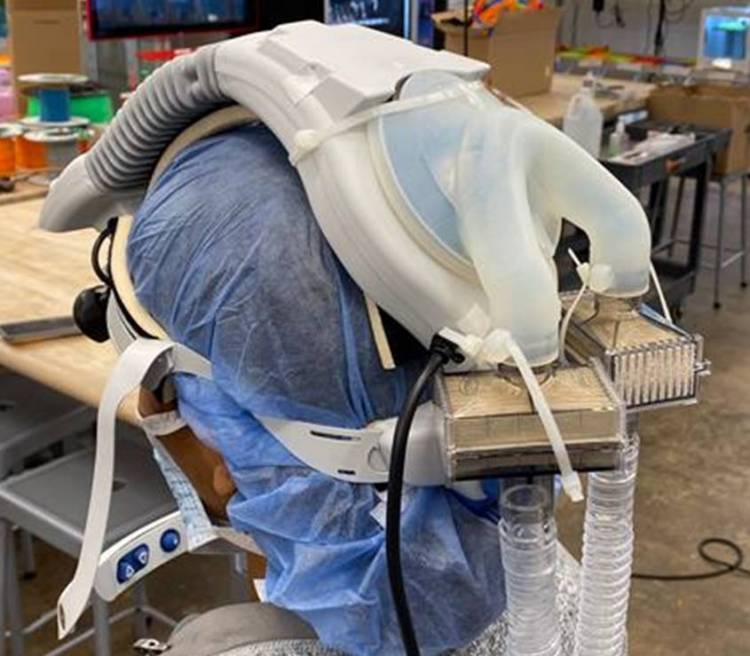Duke University issued the following announcement April 10.
A protective respirator created by the Duke COVID-19 Engineering Response Team to combat the critical shortage of medical equipment was used successfully by health care workers in two Duke Health surgical cases last week.
 Eric Richardson testing a powered, air-purifying respirator deviceWith the high need for more personal protective equipment, Duke engineering professors Ken Gall, Paul Fearis and Eric Richardson recognized the need to turn a surgical helmet, which uses room air, into a powered air purifying respirator (PAPR), which uses filtered air.
Eric Richardson testing a powered, air-purifying respirator deviceWith the high need for more personal protective equipment, Duke engineering professors Ken Gall, Paul Fearis and Eric Richardson recognized the need to turn a surgical helmet, which uses room air, into a powered air purifying respirator (PAPR), which uses filtered air.
The Duke Engineering team worked closely with Chip Bobbert, Sr. Engineer and Fabrication Architect in Duke’s Innovation Co-Lab to print and test numerous designs using their Formlabs printers.
“Basically, it is the highest level of protection we can offer our providers, particularly those that are intubating patients,”
Eric Richardson, Duke Biomedical Engineering.
“We were able to use the wonders of 3D printing here at Duke to start to print those, see what works, see what didn’t. We worked through about four or five iterations, and so we ended up with the final version that you see on the suit now,” said Fearis, Lecturing Fellow, Senior in the Department of Biomedical Engineering.
The modified protective equipment will keep doctors safe while caring for a patient.
“Basically, it is the highest level of protection we can offer our providers, particularly those that are intubating patients,” said Eric Richardson, associate professor of the practice of Biomedical Engineering.
SOLVING PRESSING CHALLENGES: 3D PRINTING OF MEDICAL GRADE FACE SHIELDS
As medical providers on the front lines work to care for patients during the COVID-19 pandemic, a Duke task force is working to ensure Duke Health reduces the supply shortage facing hospitals around the country.
READ ON DUKE TODAY
Surgical N95 respirator face masks are personal protective equipment (PPE) that health care workers use to protect themselves from airborne and fluid dangers. When they are not used, there’s a risk the worker could be exposed to bodily fluids and blood, according the Centers for Disease Control.
 Sample PAPRAs many hospitals experience PPE shortages, PAPRs are an approved alternative that provides equivalent or greater protection for health care workers. The reusable respirators completely cover health care workers’ faces and a battery-powered blower pulls air through filters or cartridges.
Sample PAPRAs many hospitals experience PPE shortages, PAPRs are an approved alternative that provides equivalent or greater protection for health care workers. The reusable respirators completely cover health care workers’ faces and a battery-powered blower pulls air through filters or cartridges.
The task force developed the 3D printed part for the adapted helmet under the guidance of Duke orthopedic spine surgeon Melissa Erickson. Her idea of modifying a surgical helmet to incorporate a filter combined with her knowledge of medical equipment led the team to deliver a protective device that could be used to safeguard health care workers during the COVID-19 pandemic. Erickson is a Weekend Executive MBA student at the Fuqua School and credits her work in operations management as inspiring her interest.
“The whole nation is undergoing a PPE shortage and our goal is to take care of our patients, take care of our communities and also take care of our healthcare workers. And what we started realizing is there is a limited number of PAPRs”
Melissa Erickson, Orthopedic Spine Surgeon
“Uniquely we have these helmets that we wear during arthroplasty surgery and we started to wonder, ‘Can these be repurposed?’ So if there’s national shortages on PPE and PAPRs, maybe we can use things that we have plenty of in the hospital and do modifications to be able to increase the number of protective personal equipment that we have to provide for health care workers.”
The device sits on top of an existing piece of medical equipment and turns a surgical helmet system into a PAPR, which basically is the highest level of protection we can offer our providers, particularly those who are intubating patients, described Richardson.
 Eric Richardson and Dr. Melissa Erickson testing the PAPR hood
Eric Richardson and Dr. Melissa Erickson testing the PAPR hood
The task force’s PAPR was rigorously tested by a HEPA certification company, Precision Air Technology, before care providers began using it. They have already made more than a dozen additional units to deliver to Duke Health. The final devices for clinical use are being printed using a Formlabs printer and resin, a Boston based company with a local office in Durham. Richardson and the task force plan to continue printing the device in order to deliver more hoods to Duke Health in the coming days.
“It's fun working with extremely talented people, and having an urgent and meaningful goal. I think we're all exhausted, but feeling like we're making impact,” said Richardson."
In addition to the PAPRs, the COVID-19 Engineering Team also 3D printed a part to create medical shields, which has been approved for use by health care workers. The task force has been working to engineer and produce a wide range of much-needed equipment including bed tents to isolate infectious patients and 3D-printed “splitters” that make a single ventilator work for more than one patient.
For information about how to download and use the 3-D printed protective respirator, contact Duke's Office of Licensing and Ventures.
 PAPRs line a bench in the 3D printing lab
PAPRs line a bench in the 3D printing lab
Original source can be found here.


 Alerts Sign-up
Alerts Sign-up